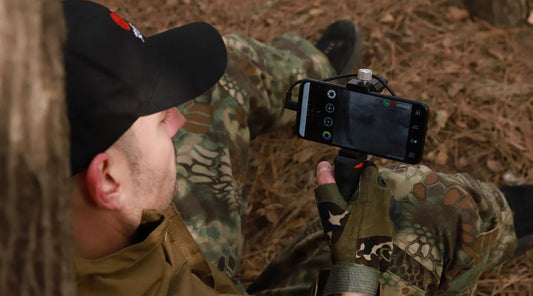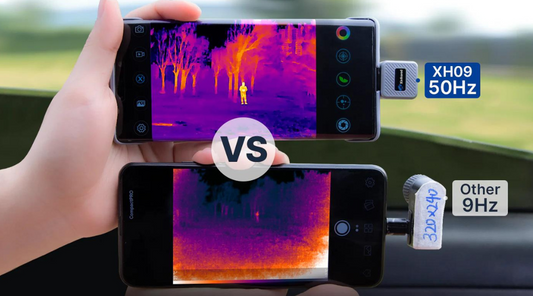Why Calibrating Your Thermal Camera Matters
In the realm of thermal imaging technology, the importance of calibrating your thermal camera cannot be overstated. This crucial step ensures not only the accuracy of your measurements but also plays a pivotal role in the reliability of diagnostic assessments. In this blog, we delve into the significance of thermal camera calibration, and its impact on various applications, and specifically explore its role in various industries
Introduction
Thermal imaging technology has become an indispensable tool in various industries, offering insights beyond the scope of traditional cameras. However, to harness its full potential, calibration is paramount. By definition, thermal camera calibration is the process of adjusting the camera to ensure accurate temperature measurements. This calibration is not a one-time affair but requires regular attention to maintain precision.

Understanding Thermal Camera Calibration
Definition and Purpose
Thermal camera calibration involves aligning the camera's temperature measurements with a known reference source. This calibration is crucial to eliminate any inaccuracies caused by environmental factors or the inherent variations in sensor performance. The purpose is to provide reliable and accurate thermal data for informed decision-making.
Impact on Image Accuracy and Interpretation
Imagine relying on thermal imaging for critical assessments, only to discover that the images are misleading due to inaccurate calibration. Calibrating your thermal camera ensures that the images accurately represent the thermal characteristics of the objects in view. This, in turn, enhances the interpretability of the images, making them more valuable for diagnostic purposes.

Importance of Calibrating Your Thermal Camera
Ensuring Measurement Accuracy
For professionals relying on thermal imaging, precision is non-negotiable. Calibrating your thermal camera ensures that temperature measurements align with real-world values, providing accurate and reliable data for applications such as electrical inspections, predictive maintenance, and more.
Enhancing Diagnostic Reliability
Whether identifying potential issues in machinery or assessing building conditions, the reliability of diagnostic assessments is contingent on accurate thermal data. Calibrating your thermal camera is a proactive measure to enhance the reliability of these diagnostics, preventing costly errors and misinterpretations.
Compliance with Industry Standards
In many industries, adherence to standards is paramount. Calibrating your thermal camera ensures compliance with industry standards, fostering confidence in the accuracy and reliability of your thermal imaging data. This is particularly crucial in sectors like healthcare, where precise temperature measurements are vital.

Key Steps in Calibrating Thermal Cameras
Temperature Reference Sources
Calibrating a thermal camera involves referencing its measurements against known temperature sources. These reference sources can include blackbody calibration devices or controlled thermal environments. Understanding and utilizing these sources are key steps in the calibration process.
Calibration Procedures
Calibrating your thermal camera involves following specific procedures outlined by the manufacturer. These procedures may include adjusting emissivity settings, compensating for ambient conditions, and validating calibration results. Regularly following these steps ensures ongoing accuracy.
Regular Maintenance Practices
Calibration is not a one-and-done process. Regular maintenance practices, including periodic recalibration, are essential to account for any changes in the camera's performance over time. This proactive approach safeguards against drift and ensures consistent accuracy.

Applications of Thermal Imaging in Diverse Fields
Thermal imaging has emerged as a versatile technology with applications spanning various industries, revolutionizing the way professionals conduct inspections and assessments. Let's explore the diverse applications of thermal imaging and how its calibrated accuracy plays a pivotal role.
Overview of Thermal Imaging in Construction and Infrastructure
In the realm of construction, thermal imaging has become an invaluable asset. Its non-invasive nature allows for the identification of structural issues without the need for destructive testing. Professionals can easily detect insulation gaps, locate hidden moisture, and assess the overall integrity of buildings. Calibrating thermal cameras ensures that these assessments provide accurate and reliable information, aiding in preventive maintenance and cost-effective improvements.

Enhancing Efficiency in Electrical Inspections
Calibrated thermal cameras play a crucial role in electrical inspections by identifying potential issues before they escalate. Electrical systems often exhibit abnormal heat patterns before failure, and thermal imaging can quickly pinpoint these anomalies. Whether it's loose connections, overloaded circuits, or faulty components, the accuracy of thermal measurements is paramount in preventing electrical failures and ensuring the safety of facilities.

Advancements in Medical Diagnostics with Thermal Imaging
In the healthcare sector, thermal imaging has evolved beyond its traditional applications. Calibrated thermal cameras contribute to medical diagnostics by detecting variations in skin temperature that may indicate underlying health conditions. From identifying inflammation to assisting in early breast cancer detection, thermal imaging has the potential to enhance diagnostic capabilities. The precision achieved through calibration is critical in ensuring reliable and accurate medical interpretations.
Improving Security and Surveillance Systems
Thermal imaging has found its place in security and surveillance, especially in low-light or adverse weather conditions. Calibrated thermal cameras provide enhanced visibility by detecting infrared radiation emitted by objects. This makes them effective for perimeter surveillance, intrusion detection, and search and rescue operations. The accuracy in temperature measurements ensures reliable identification of potential threats and enhances overall security measures.

Precision in Industrial Predictive Maintenance
Industries rely on predictive maintenance to minimize downtime and optimize operations. Calibrated thermal imaging aids in the early detection of equipment anomalies, such as overheating motors or malfunctioning machinery. By identifying issues before they lead to costly breakdowns, businesses can streamline maintenance efforts and extend the lifespan of critical equipment.
Environmental Monitoring and Conservation Efforts
In environmental science, thermal imaging contributes to monitoring and conservation efforts. Calibrated thermal cameras assist researchers in studying wildlife behavior, mapping ecosystems, and monitoring climate change impacts. The precision in temperature measurements ensures accurate data collection, supporting informed decision-making for environmental preservation.

Challenges and Solutions in Thermal Camera Calibration
Common Calibration Issues
Despite the importance of calibration, challenges can arise. Common issues include sensor drift, changes in environmental conditions, and variations in emissivity. Understanding these challenges is the first step in addressing them effectively.
Best Practices for Overcoming Calibration Challenges
Implementing best practices, such as regular checks, using stable temperature references, and staying updated on manufacturer recommendations, can help overcome calibration challenges. Proactive management of these issues ensures the continued accuracy of thermal imaging data.

Future Trends in Thermal Imaging Technology
Advancements in Calibration Techniques
As technology evolves, so do calibration techniques. Ongoing research and development are focused on enhancing calibration processes, making them more efficient and user-friendly. Stay tuned for advancements that promise even greater accuracy in thermal imaging.
Emerging Technologies in Thermal Camera Calibration
The future holds promising advancements in thermal camera calibration, including integrated self-calibration features and improved sensor technologies. These innovations aim to simplify the calibration process further and increase accessibility for users across diverse industries.
In conclusion, calibrating your thermal camera is not merely a technicality but a cornerstone in unlocking the true potential of thermal imaging technology. From ensuring measurement accuracy to enhancing diagnostic reliability, calibration plays a pivotal role. Specifically, in the realm of architectural assessments, calibrated thermal cameras offer a non-destructive and efficient means of identifying building issues and promoting energy efficiency.

As you venture into the world of thermal imaging, remember that regular calibration is your ally in maintaining the integrity of your data. Embrace the advancements, stay informed on best practices, and let the precision of calibrated thermal imaging guide your assessments.





